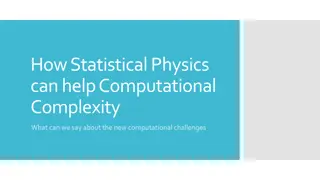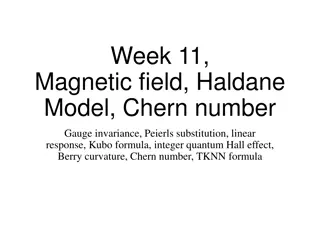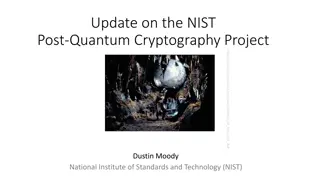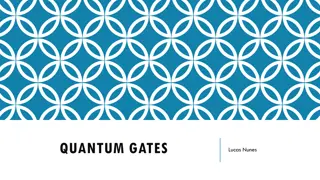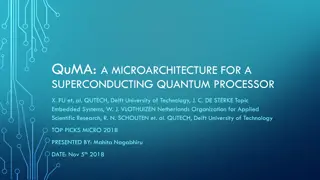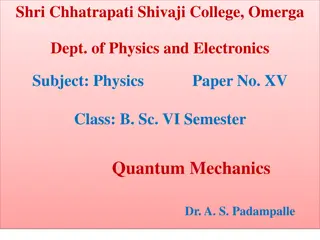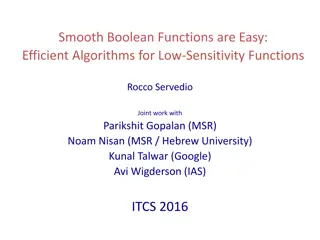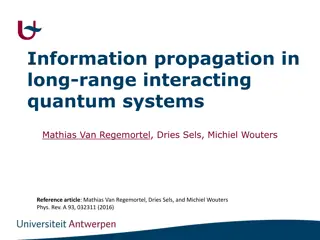Understanding Computational Complexity in Quantum Hamiltonians
The Bose-Hubbard model is proven to be QMA-complete, indicating the challenge in solving ground energy problems in quantum systems. Various classes of Hamiltonians, such as k-local and stoquastic, exhibit different complexities in computing ground energy. While some systems with QMA-complete ground energy problems are surprisingly simple, the complexity of natural models from condensed matter physics, like the XY model, remains unclear. Perturbation theory poses limitations due to coefficient scaling with system size.
- Quantum Hamiltonians
- Computational Complexity
- Bose-Hubbard Model
- Ground Energy
- Condensed Matter Physics
Uploaded on Sep 11, 2024 | 0 Views
Download Presentation

Please find below an Image/Link to download the presentation.
The content on the website is provided AS IS for your information and personal use only. It may not be sold, licensed, or shared on other websites without obtaining consent from the author. Download presentation by click this link. If you encounter any issues during the download, it is possible that the publisher has removed the file from their server.
E N D
Presentation Transcript
The Bose-Hubbard model is QMA-complete Andrew M. Childs David Gosset Zak Webb arXiv: 1311.3297 Institute for Quantum Computing University of Waterloo
Solving for the ground energy of a quantum system can be viewed as a quantum constraint satisfaction problem. How difficult is it? Image source: http://www.condmat.physics.manchester.ac.uk/imagelibrary/
The computational difficulty of computing the ground energy has been studied for many broad classes of Hamiltonians Class of Hamiltonians Ground energy problem k-local Hamiltonian problem Complexity Local QMA-complete for ? ? [Kitaev 1999] [Kempe, Regev 2003] [Kempe, Kitaev, Regev 2006] Quantum k-SAT (testing frustration-freeness) Frustration-free Contained in P for ? = ? QMA1-complete for ? ? [Bravyi 2006] [G. , Nagaj 2013 ] Stoquastic (no sign problem ) Stoquastic k-local Hamiltonian problem Contained in AM MA-hard [Bravyi et. al. 2006] QMA-complete [Liu, Christandl, Verstraete 2007] [Wei, Mosca, Nayak 2010] Fermions or Bosons
Systems with QMA-complete ground energy problems can be surprisingly simple 2-local Hamiltonian on a 2D grid [Oliveira Terhal 2008] ?? ??,?+1 2-local Hamiltonian on a line with qudits [Aharonov et. al 2009] [Gottesman Irani 2009] ?? Hubbard model on a 2D grid with site-dependent magnetic field [Schuch Verstraete 2009]. Versions of the XY, Heisenberg, and other models with adjustable coefficients [Cubitt Montanaro 2013] E.g., ??? ?+ ?? ??? ?) ?????(??
However, the complexity of many natural models from condensed matter physics is still not understood, e.g., the XY model on a graph ??? ?+ ?? ??? ?) ?? ?(?) (??
However, the complexity of many natural models from condensed matter physics is still not understood, e.g., the XY model on a graph ??? ?+ ?? ??? ?) ?? ?(?) (?? Unfortunately, proof techniques using perturbation theory * require coefficients which grow with system size, e.g., [Cubitt Montanaro 2013] Allowed to scale polynomially with n ??? ?+ ?? ??? ?) ?????(?? *[Kempe Kitaev Regev 2006], [Oliveira Terhal 2008]
However, the complexity of many natural models from condensed matter physics is still not understood, e.g., the XY model on a graph ??? ?+ ?? ??? ?) ?? ?(?) (?? Unfortunately, proof techniques using perturbation theory * require coefficients which grow with system size, e.g., [Cubitt Montanaro 2013] Allowed to scale polynomially with n ??? ?+ ?? ??? ?) ?????(?? In this work we consider a model of interacting Bosons on a graph with no adjustable coefficients *[Kempe Kitaev Regev 2006], [Oliveira Terhal 2008]
The Bose-Hubbard model on a graph Adjacency matrix ?(?) (a symmetric 0-1 matrix) Bosons move between adjacent vertices and experience an energy penalty if two or more particles occupy the same site.
The Bose-Hubbard model on a graph Adjacency matrix ?(?) (a symmetric 0-1 matrix) Bosons move between adjacent vertices and experience an energy penalty if two or more particles occupy the same site. Conserves total number of particles ??+ ? ??(?,?) = ? ?,? ??(?)???? ? ????? 1 Movement Repulsive on-site interaction ?? annihilates a particle at site i ??= ?? ?? counts the number of particles at site i
The Bose-Hubbard model on a graph Adjacency matrix ?(?) (a symmetric 0-1 matrix) Bosons move between adjacent vertices and experience an energy penalty if two or more particles occupy the same site. Conserves total number of particles ??+ ? ??(?,?) = ? ?,? ??(?)???? ? ????? 1 Movement Repulsive on-site interaction (t,U)-Bose-Hubbard Hamiltonian problem Input: A graph ?, number of particles ?, energy threshold ?, and precision parameter ? Problem: Is the ground energy of ??(?,?) in the ?-particle sector at most ?, or at least ? + ? ? (promised that one of these conditions holds)
Complexity of (t,U)-Bose Hubbard Hamiltonian Theorem: (t,U)-Bose Hubbard Hamiltonian is QMA-complete for all ?,? > 0. ? QMA-complete [our results] ?
Complexity of (t,U)-Bose Hubbard Hamiltonian Theorem: (t,U)-Bose Hubbard Hamiltonian is QMA-complete for all ?,? > 0. ? QMA-complete [our results] ? Contained in AM QMA [Bravyi et. al 2006] Stoquastic
Complexity of (t,U)-Bose Hubbard Hamiltonian Theorem: (t,U)-Bose Hubbard Hamiltonian is QMA-complete for all ?,? > 0. ? Contained in QMA QMA-complete [our results] ? Contained in AM QMA [Bravyi et. al 2006] Stoquastic
Complexity of (t,U)-Bose Hubbard Hamiltonian Theorem: (t,U)-Bose Hubbard Hamiltonian is QMA-complete for all ?,? > 0. ? Contained in QMA QMA-complete [our results] ? Contained in AM QMA [Bravyi et. al 2006] Stoquastic In the limit ? of infinite repulsion (i.e., hard core bosons) there is only ever 0 or 1 particle at each vertex, and the Hamiltonian is equivalent to a spin model
A related class of 2-local Hamiltonians Conserves total magnetization (Hamming weight) XY Hamiltonian problem Input: A graph ?, magnetization ?, energy threshold ?, precision parameter ? Problem: Is the ground energy of ?? in the sector with magnetization ? at most ?, or at least ? + ? ? (promised one of these conditions holds) Theorem: XY Hamiltonian is QMA-complete.
Quantum Merlin Arthur QMA: class of decision problems where yes instances can be efficiently verified on a quantum computer. Every instance ? of a problem in QMA has a verification circuit |0 ?? Wm-1Wm-2 W0 |? If ? is a yes instance there exists ? (a witness) which is accepted with high probability. If ? is a no instance every state has low acceptance probability. Ground energy problems are usually contained in QMA (witness = ground state ; verification circuit = energy measurement) Proving QMA-hardness is more involved
Proving QMA-hardness for ground energy problems QMA Verification circuit for ? Hamiltonian |0 ?? ?? Wm-1Wm-2 W0 |? Desired properties: Ground energy of ?? is small Verification circuit accepts a state with high probability ? is a yes instance
Proving QMA-hardness for ground energy problems QMA Verification circuit for ? Hamiltonian |0 ?? ?? Wm-1Wm-2 W0 |? Desired properties: Ground energy of ?? is small Verification circuit accepts a state with high probability ? is a yes instance Key intermediate step: Design a Hamiltonian where each ground state encodes a quantum computation associated with the circuit, e.g., Feynman-Kitaev Hamiltonian has ground states
Proving QMA-hardness for ground energy problems QMA Verification circuit for ? Hamiltonian |0 ?? ?? Wm-1Wm-2 W0 |? Desired properties: Ground energy of ?? is small Verification circuit accepts a state with high probability ? is a yes instance Key intermediate step: Design a Hamiltonian where each ground state encodes a quantum computation associated with the circuit, e.g., Feynman-Kitaev Hamiltonian has ground states In our case we show how to encode the history of an ?-qubit, ?-gate computation in the groundspace of the ?-particle Bose-Hubbard model on a graph with ????(?,?) vertices
Encoding one qubit with one particle When ? = 1 the Hamiltonian is just the adjacency matrix of the graph. We use a variant of the Feynman-Kitaev circuit-to-Hamiltonian mapping which outputs a symmetric 0-1 matrix.
Encoding one qubit with one particle When ? = 1 the Hamiltonian is just the adjacency matrix of the graph. We use a variant of the Feynman-Kitaev circuit-to-Hamiltonian mapping which outputs a symmetric 0-1 matrix. Example (building block for later on) H H (HT) HT HT H (HT) H Vertices are labeled ?,?,? ? 0,1 ?,? [8]
Encoding one qubit with one particle When ? = 1 the Hamiltonian is just the adjacency matrix of the graph. We use a variant of the Feynman-Kitaev circuit-to-Hamiltonian mapping which outputs a symmetric 0-1 matrix. Example (building block for later on) H H (HT) HT HT H (HT) H Vertices are labeled ?,?,? ? 0,1 ?,? [8] Groundstates of the adjacency matrix: 1 ??,0 = ? 1 + ? ? 2 + ? 3 + ?? ? 4 + ? |5 + ?? ? 6 + ? 7 + ? ? |8 |? 8 a specific state ??,1 = ??,0 encodes the computation where the circuit is complex-conjugated for ? 0,1 .
More particles (? > 1) ?(?)= smallest eigenvalue of ?(?) ??+ ? ??(?,?) = ? ?,? ??(?)???? ? ????? 1 ???(?) 0
More particles (? > 1) ?(?)= smallest eigenvalue of ?(?) ??+ ? ??(?,?) = ? ?,? ??(?)???? ? ????? 1 ???(?) 0 If the ground energy is ???(?) we say the groundspace is frustration-free. In this case the groundspace is the same for all ?,?>0!
More particles (? > 1) ?(?)= smallest eigenvalue of ?(?) ??+ ? ??(?,?) = ? ?,? ??(?)???? ? ????? 1 ???(?) 0 If the ground energy is ???(?) we say the groundspace is frustration-free. In this case the groundspace is the same for all ?,?>0! We design a class of graphs where the frustration-free ?-particle ground states encode ?-qubit computations. These graphs are built out of multiple copies of
Graphs for two-qubit gates A graph shaped like this Two qubit gate ? 4096 vertex graph made from 32 copies of ?
Graphs for two-qubit gates A graph shaped like this Two qubit gate ? 4096 vertex graph made from 32 copies of ? Single-particle ground states encode a qubit and one out of four possible locations
Graphs for two-qubit gates A graph shaped like this Two qubit gate ? 4096 vertex graph made from 32 copies of ? Single-particle ground states encode a qubit and one out of four possible locations
Graphs for two-qubit gates A graph shaped like this Two qubit gate ? 4096 vertex graph made from 32 copies of ? Single-particle ground states encode a qubit and one out of four possible locations
Graphs for two-qubit gates A graph shaped like this Two qubit gate ? 4096 vertex graph made from 32 copies of ? Single-particle ground states encode a qubit and one out of four possible locations
Graphs for two-qubit gates A graph shaped like this Two qubit gate ? 4096 vertex graph made from 32 copies of ? Single-particle ground states encode a qubit and one out of four possible locations
Graphs for two-qubit gates A graph shaped like this Two qubit gate ? 4096 vertex graph made from 32 copies of ? Single-particle ground states encode a qubit and one out of four possible locations
Graphs for two-qubit gates A graph shaped like this Two qubit gate ? 4096 vertex graph made from 32 copies of ? Single-particle ground states encode a qubit and one out of four possible locations
Graphs for two-qubit gates A graph shaped like this Two qubit gate ? 4096 vertex graph made from 32 copies of ? Single-particle ground states encode a qubit and one out of four possible locations
Graphs for two-qubit gates A graph shaped like this Two qubit gate ? 4096 vertex graph made from 32 copies of ? Single-particle ground states encode a qubit and one out of four possible locations
Graphs for two-qubit gates A graph shaped like this Two qubit gate ? 4096 vertex graph made from 32 copies of ? Single-particle ground states encode a qubit and one out of four possible locations Two-particle frustration-free ground states have the form 1 1 both particles on the left,? + both particles on the right ,?? 2 2
Graphs for two-qubit gates A graph shaped like this Two qubit gate ? 4096 vertex graph made from 32 copies of ? Single-particle ground states encode a qubit and one out of four possible locations Two-particle frustration-free ground states have the form 1 1 both particles on the left,? + both particles on the right ,?? 2 2
Graphs for two-qubit gates A graph shaped like this Two qubit gate ? 4096 vertex graph made from 32 copies of ? Single-particle ground states encode a qubit and one out of four possible locations Two-particle frustration-free ground states have the form 1 1 both particles on the left,? + both particles on the right ,?? 2 2
Constructing a graph from a verification circuit Connect up the graphs for two-qubit gates to mimic the circuit, e.g., ?2 ?1 Good news: there are two-particle ground states which encode computations ,? + + ,?1? ,?1? + + ,?1? ,?1? + ,?2?1? Bad news: there are other two-particle ground states where the particles are in regions of the graph where they shouldn t be. To get rid of the bad states, we develop a method for enforcing occupancy constraints , i.e. penalizing certain configurations of the particles. To prove our results we establish spectral bounds without using perturbation theory.
Open questions Improvements to our construction? E.g., remove restriction to fixed particle number and/or consider simple graphs (no self loops). Complexity of other models of indistinguishable particles on graphs? bosons or fermions with nearest-neighbor interactions Attractive interactions Negative hopping strength Complexity of other spin models on graphs? Antiferromagnetic Heisenberg model Models with only one type of 2-local term: for which 4 4 matrices is the model ?,? ?(?) ?? QMA-complete?








